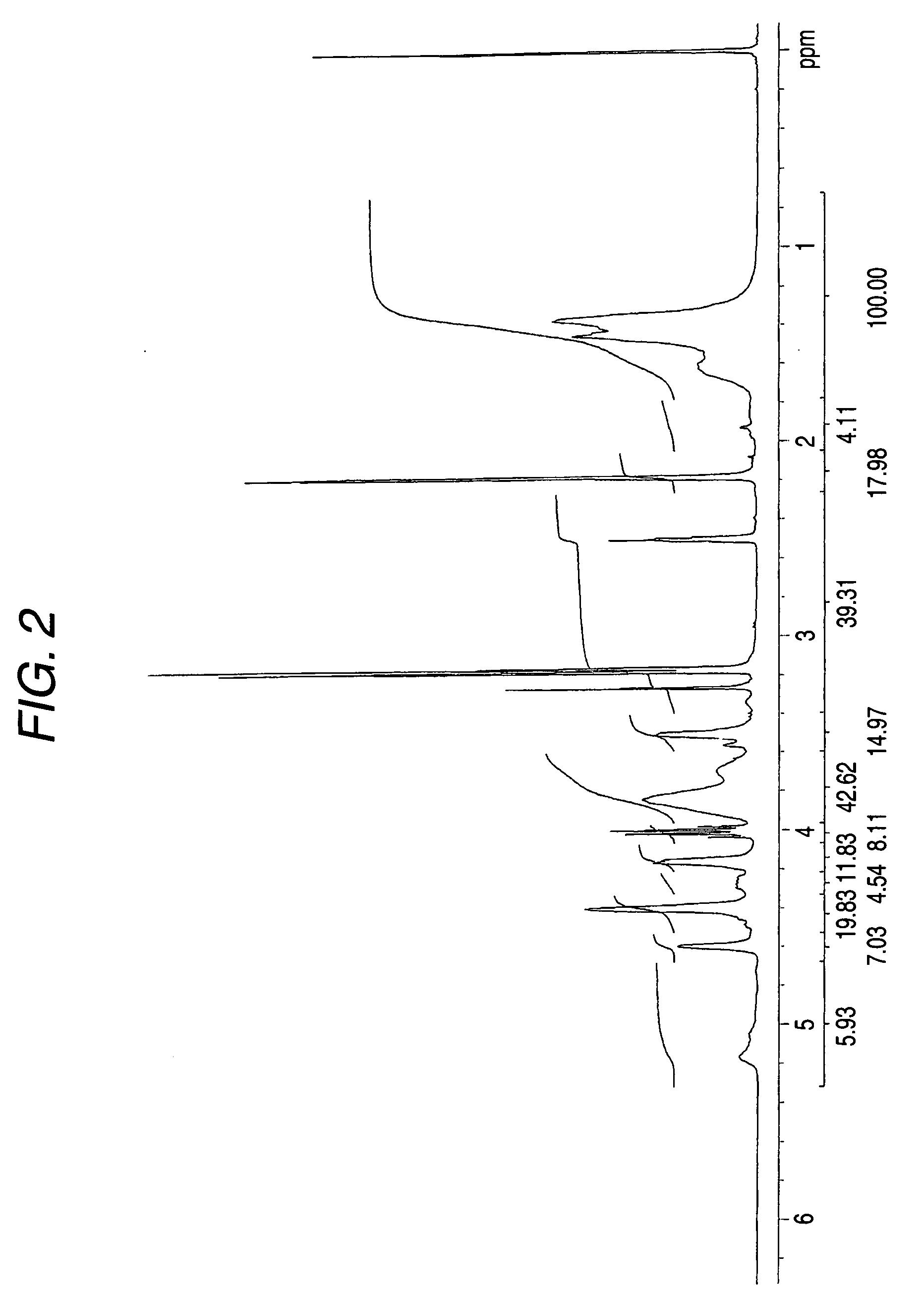Acetoacetic Ester Group-Containing Polyvinyl Alcohol-Based Resin, Resin Composition, and Uses Thereof
a technology of acetoacetic ester and polyvinyl alcohol, which is applied in the direction of unsaturated alcohol polymer adhesives, adhesive types, thermography, etc., can solve the economic disadvantage of the process, achieve excellent viscosity stability, excellent transparency, and less amoun
- Summary
- Abstract
- Description
- Claims
- Application Information
AI Technical Summary
Benefits of technology
Problems solved by technology
Method used
Image
Examples
example 1
Production of 1,2-diol-modified PVA-based resin
[0210]Into a reaction tank fitted with a reflux condenser, a dropping funnel, and a stirrer were charged 1200 g of vinyl acetate, 216 g of methanol, and 72 g (3% by mol) of 3,4-diacetoxy-1-butene, then 0.05% by mol (based on charged vinyl acetate) of azobisisobutyronitrile was charged thereto, and temperature was elevated with stirring under a nitrogen stream to initiate polymerization. At the time when polymerization rate of vinyl acetate reached 89%, a predetermined amount of m-dinitrobenzne was added thereto to finish the polymerization. Subsequently, unreacted vinyl acetate monomer was removed to outside of the system by a method of blowing methanol vapor therein to obtain a methanol solution of a copolymer.
[0211]Then, the solution was diluted with methanol to adjust the concentration to 35% and the resulting solution was charged into a kneader. While the solution temperature was maintained at 40° C., a 2% methanol solution of sodiu...
example 2
Production of 1,2-diol-modified PVA-based resin
[0245]Into a reaction tank fitted with a reflux condenser, a dropping funnel, and a stirrer were charged 1200 g of vinyl acetate, 360 g of methanol, and 36 g (1.5% by mol) of 3,4-diacetoxy-1-butene, then 0.03% by mol (based on charged vinyl acetate) of azobisisobutyronitrile was charged thereto, and temperature was elevated with stirring under a nitrogen stream to initiate polymerization. At the time when the polymerization rate of vinyl acetate reached 90%, a predetermined amount of m-dinitrobenzne was added thereto to finish the polymerization. Subsequently, unreacted vinyl acetate monomer was removed to outside of the system by a method of blowing methanol vapor therein to obtain a methanol solution of a copolymer.
[0246]Then, the solution was diluted with methanol to adjust the concentration to 35% and the resulting solution was charged into a kneader. While the solution temperature was maintained at 40° C., a 2% methanol solution of...
example 3
Production of 1,2-diol-modified PVA-based resin
[0251]Into a reaction tank fitted with a reflux condenser, a dropping funnel, and a stirrer were charged 1500 g of vinyl acetate, 75 g of methanol, and 240 g (8% by mol) of 3,4-diacetoxy-1-butene, then 0.03% by mol (based on charged vinyl acetate) of azobisisobutyronitrile was charged thereto, and temperature was elevated with stirring under a nitrogen stream to initiate polymerization. At the time when the polymerization rate of vinyl acetate reached 73%, a predetermined amount of m-dinitrobenzne was added thereto to finish the polymerization. Subsequently, unreacted vinyl acetate monomer was removed to outside of the system by a method of blowing methanol vapor therein to obtain a methanol solution of a copolymer.
[0252]Then, the solution was diluted with methanol to adjust the concentration to 35% and the resulting solution was charged into a kneader. While the solution temperature was maintained at 40° C., a 2% methanol solution of s...
PUM
| Property | Measurement | Unit |
|---|---|---|
| weight ratio | aaaaa | aaaaa |
| weight ratio | aaaaa | aaaaa |
| boiling point | aaaaa | aaaaa |
Abstract
Description
Claims
Application Information
 Login to View More
Login to View More - R&D
- Intellectual Property
- Life Sciences
- Materials
- Tech Scout
- Unparalleled Data Quality
- Higher Quality Content
- 60% Fewer Hallucinations
Browse by: Latest US Patents, China's latest patents, Technical Efficacy Thesaurus, Application Domain, Technology Topic, Popular Technical Reports.
© 2025 PatSnap. All rights reserved.Legal|Privacy policy|Modern Slavery Act Transparency Statement|Sitemap|About US| Contact US: help@patsnap.com



